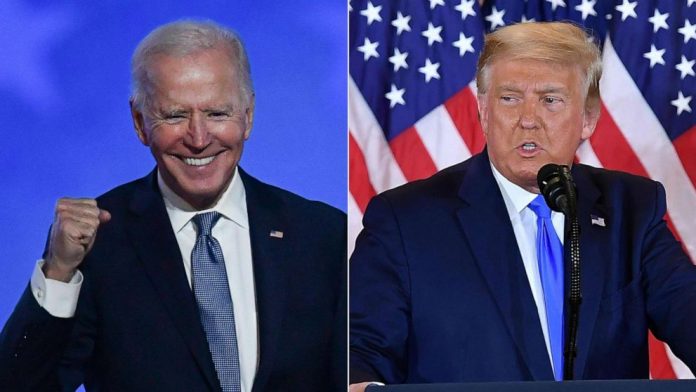
The election that changed how Americans vote also changed the speed with which some of their votes are counted, leaving the country hanging for an official outcome even as Biden improved on Hillary Clinton’s performance nationally in a range of voting groups.
An unprecedented 64% of voters cast their ballots early, including 34% by mail — with those votes still being counted in several key states. Winners weren’t projected by the wee hours in states including Georgia, Michigan, North Carolina, Pennsylvania and Wisconsin.
Nevertheless, the national exit poll supported some broad conclusions. One was the still-growing share of racial and ethnic minorities in the electorate — 35%, up from 30% in 2016 and from 10% when the first exit poll was produced in 1976. The diversity train rolled on.
Trump improved in some gauges. Less than half of voters — 44% — said he has the temperament to serve effectively as president, but that figure was up from 35% four years ago. And while 53% saw him unfavorably, that figure was down from 59% in 2016.
At the same time, the exit poll found Biden winning independents — often swing voters in national elections — by 14 percentage points, 54-40%. Trump won them by 6 points in 2016. Biden won moderates by 31 points in exit poll results, 64-33%. Hillary Clinton won them by 13 points.
Biden also won first-time voters by 34 points, compared to Clinton’s 20 points. Voters who have served in the military backed Trump by 7 points, down from his 24-point margin in this group in 2016. Biden was +3 points in the suburbs versus Trump’s +4 four years ago. The gender gap narrowed considerably, but largely because Trump won men by 1 point compared with 11 points four years ago.
Trump’s approval rating — 47-51% approve-disapprove — was underwater, but mildly so. The only two presidents with negative approval ratings at the time of their second election both lost — Jimmy Carter and George H.W. Bush — but they had much lower approval than Trump.
Trump and Biden fought essentially to a standstill on who is better able to handle the economy, while Biden led — 51-43%– as better to handle the coronavirus pandemic. And voters by about the same margin — 51-42% — sided with Biden on stopping the spread of the virus as a priority, rather than with Trump on rebuilding the economy as a priority.
That’s even though 55% said the pandemic had caused them financial hardship; those who said so supported Biden by 30 points.
The public was divided evenly on whether the U.S. response to the pandemic has gone well or badly, with big state-to-state differences. At the same time, twice as many said it has gone very badly — 34% — as very well — 17%.
In a much larger disconnect for Trump, voters by 67-30% saw wearing a face mask as a public health responsibility rather than a personal choice, with sharp vote differences between the two groups.
Among other results from the national exit poll, 66% of voters called global warming a serious problem; 57% expressed a favorable opinion of the Black Lives Matter movement; 52% said the Supreme Court should uphold Obamacare, compared with 43% who said it should be overturned; and 51% said abortion should be legal in all or most cases, a low in exit polls back to 1992.
Lastly, two results were heartening, perhaps, across partisan lines: 93% said their state makes it somewhat or very easy to vote, and 87% were somewhat or very confident that their vote would be counted fairly. Eventually.












